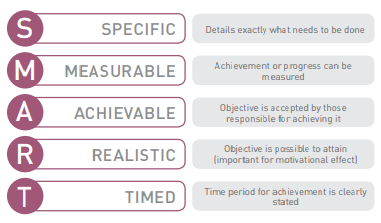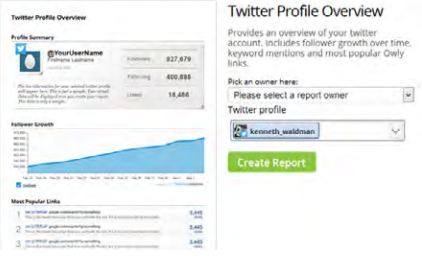17.4: Step-by-step guide to creating a social media strategy
- Page ID
- 24966
Social media is fast-moving, which means proper planning is vital to success. Effective social media strategies come from embracing the fact that social media is a two-way communication tool. Organisations need the resources not only to push messages out, but to deal quickly with the messages coming in, too.
Planning is the foundation of success. Here is one method to approaching social media strategically.
Step 1. Get buy-in
Getting buy-in for using social media is essential. It may be seen as a free resource, but even if you are not paying for exposure, there is a time and resource investment required. A number of stakeholders will need to be aware of your social media plans, and these may be both internal and external. And, of course, you will need sign-off for any budgeting or additional resourcing requirements.
It is important to choose your platforms wisely, and to consider the risks of not being on social media as well!
Addressing the various stakeholders will also force you to do the necessary research and planning to take the next steps.
Step 2. Listen and understand the landscape
Social media is more than the social spaces you may interact with in your personal capacity. A good first step to understanding the full social media landscape is to listen well to conversations your target market is already having around your brand or industry.
Some important questions to answer include:
- What conversation already exists around your brand, your industry and your competitors?
- Do they have the facts?
- Where does it take place?
- Who is doing most of the talking?
- What are the emotions involved in conversations about your brand?
- What are the motivations of those that comment on your brand online?
- What can you, as a brand, add to this conversation? Is it valuable?
Online monitoring tools such as BrandsEye (www.brandseye.com) can help you with the listening part of your planning, but in the early stages you may want to start with free tools such as Google Alerts (www.google.com/alerts).
Step 3. Analyse
Using all the data you have been gathering, analyse! Think critically about social media and your brand, as well as your brand’s broader marketing, communication and business challenges. All of this should be looked at within the context of the information that you already know about your local marketing and business environment.
Your outcomes here should include:
- A list of the social channels and platforms your brand should be on. This is based on who your customers are, where they interact, and where they expect to interact with you.
- Non-official groups or communities that already exist, which may have been created by fans.
- An overview of the existing conversation (volume, frequency and sentiment), as well as any content or conversation themes that occur.
- An overview of what your competitors are doing in this space.
- A list of potential brand evangelists and influencers in your industry.
Step 4. Set objectives
Your objectives are the desired outcome of your social media strategy. Your ultimate objective, as to what social media should achieve for your business, should be established upfront and be based within the context of your marketing and business challenges. After listening and analysing you can now set specific social media objectives that will feed into your overall outcome. You need to identify exactly how you will use social media to reach the business objectives for your organisation, and then set SMART objectives that will help you to achieve these.
To make them tangible and measurable, establish key performance indicators (KPIs) for your objectives, with benchmarks and targets where appropriate. Determine SMART objectives shown below.

For example, your objective could be to grow a community of fans around your brand in a particular country. Your KPI might therefore be fan numbers, and you could set a target of 5 000 Facebook fans over six months.
Step 5. Create an action plan
Once you have a clear idea of what you want, you can begin compiling an action plan to get there.
This is where you need to make sure that you have created the necessary documents and processes that form the foundation of your plan. Remember to keep your and chosen platform in mind when making these plans. You will need to:
- Decide on the roles and responsibilities of the project team and other stakeholders.
- Determine what social media tools you will use.
- Commit to a frequency and volume of activity, and how quickly you will respond.
- Develop a conversation plan.
- Create tone of voice guidelines, frequently asked questions, community guidelines and content plans.
Step 6. Implement
This is the fun part! It’s time for your plans to kick off and put all that research and thought into action. Set up your platforms according to the specific guidelines for the platform. Most platforms have helpful and informative guidance for businesses wanting to be on their site. They also provide brand packs and assistance in establishing yourself on the site. Pinterest, for example, offers detailed guidance on their platform, see: https://business.pinterest.com/en.
Alert stakeholders that you are starting your engagement plans, and make sure you have tracking in place. Continue to monitor for mentions of your organisation and responses to your messages. Keep to your general plan, but be prepared to adapt.
Step 7. Track, analyse, optimise
The beautiful thing about digital marketing is that you can track every single user interaction and use this information to learn from and improve your efforts continually. You should track the success of your social media campaigns on an ongoing basis, and set milestones for your team at less frequent intervals (every couple of months or so), when you will sit down and do an in-depth review.
There are several tools you can use for tracking social media. You will need to build a suite of tools to suit your measurement and reporting requirements.
Platform insights
From the previous chapter you saw how each major platform offers its own analytics to businesses and brands that sign up for business pages or profiles. These are a useful starting point for reporting on your social media efforts, from numbers of followers or fans, to interactions with the content you share.
Web analytics
If you are using social media channels to send traffic to your own website, you should tag the links so that you can segment that traffic in your website reports.
Read more about this in the Data analytics chapter
In Google Analytics (www.google.com/analytics), you would use campaign tracking parameters.
URL Shorteners
URL shortening services such as bit.ly, goo.gl and ow.ly offer usage data that will tell you how many users click on links you share, when they click on them, and where in the world they are from.
UTM parameters
UTM stands for Urchin Tracking Module because Urchin Tracking was one of the original web analytics software developers who came up with these tags.
UTM parameters are short text codes that you add to a URL to track data about users and traffic sources. UTM parameters are also known as UTM codes or UTM tags. UTM parameters do not modify any content on the site, but are simply for tracking purposes (Hootsuite, 2017).
UTM parameters help you to analyse how each of the marketing channels you have invested in, such as search, display, or social, have contributed to your campaign. You will be able to see which channel sent the most number of users to your site, what the conversion rate of the various channels are and which channel offers the best return on investment. You can also organise your data so that you can compare different campaigns to assess content, timing, distribution platforms, and so on. They are invaluable tools (Kissmetrics, 2017).
Here is an example that you saw in Chapter 16. Note the UTM tag at the end of the URL.
www.redandyellow.co.za/5-way...er-women/?utm_ source=newsletter&utm_medium=email&utm_campaign=AugNewsletter
You can read more on how to use UTM parameters at https://blog.kissmetrics.com/ utm-parameters-video/ which also includes a video on how to use UTM tags on Google Analytics.
Online monitoring software
Online monitoring software, also known as sentiment analysis or opinion mining software, is an important measurement investment that you will need to make. It helps you to keep track of all mentions of your brand, and to understand the sentiment and influence of those mentions. You should be tracking your reputation for trends and changes over time. Some popular choices are: BrandsEye (www. brandseye.com ), Brandwatch (www.brandwatch.com ), SEM Rush (www.semrush. com ) and Hootsuite (www.hootsuite.com ) (Ganot, 2016).
Social media dashboards
There are a number of services that make it easier for you to centralise management of your social media properties, as well as making collaborative management easier. They also integrate analytics data from a number of sources, making reporting easier.

Some dashboards even let you schedule or respond to posts directly from the interface.
Some services include:
Everypost (http://everypost.me)
Buffer (http://buffer.com)
Hootsuite (www.hootsuite.com)
Nuvi (https://www.nuvi.com/)
Sprout Social (www.sproutsocial.com)
Socialbakers (www.socialbakers.com)
Tweetstats (www.tweetstats.com)


